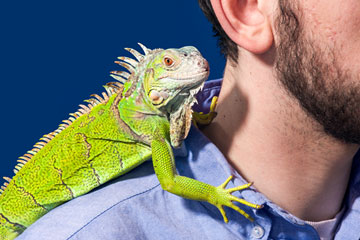
Many people with depression or anxiety are being prescribed emotional support animals: dogs, cats, pigs, hedgehogs and, yes, iguanas.
(2 of 3)
Livingood acknowledges that certification standards for ESAs are far less stringent than those for service animals that aid people with visual impairments and other physical disabilities. ESAs are also different from psychiatric-service dogs, which are often used to rehabilitate veterans with posttraumatic stress disorder or depression but trained to perform tasks for their owners. ESAs, by contrast, "don't need to be trained," he says. "It's their very presence that ameliorates the negative effects of a person's disorder."
The Centers for Disease Control and Prevention and other authorities have established that the presence of a pet has positive health benefits. Simply petting a dog, for instance, generally decreases blood pressure and heart rate and appears to raise levels of serotonin, the neurotransmitter associated with feelings of happiness and well-being.
These physiological responses have never been fully explained. Linda Porter-Wenzlaff, who teaches animal therapy at the University of Texas Health Science Center and also has a private psychotherapy practice, says interacting with domesticated animals may return us to a more elemental state of existence. "One of the things that animals do for us is externalize our focus," she says. "So if we're stewing about something or concerned or anxious or worried, they bring us back to the here and now."
These positive effects might be why Louisville basketball star Kevin Ware adopted a puppy days after suffering a gruesome leg injury on the court that will require extensive physical rehab. ("We named him Scar to represent my struggle," Ware posted to Instagram on April 2.)
Of course, regular pet owners like Ware get the same benefits as those with a certified ESA--they just don't have a doctor's note. That gray area causes confusion and even abuse of laws protecting ESAs. In the mid-2000s, New York City restaurant owners started noticing an influx of customers with "service" dogs that didn't seem to provide any obvious service. In two incidents on different airlines, flight attendants puzzled over how to accommodate the presence of emotional-service goats in the cabin. Complicating the issue further was the growing diversity of critters aiding people with physical disabilities: boa constrictors that warn their owners of oncoming seizures; capuchin monkeys that help quadriplegics eat and drink; parrots that verbally calm owners who suffer from bipolar disorder.
In 2011 the Department of Justice redefined what constitutes a service animal under the Americans With Disabilities Act to exclude ESAs. They are still protected under the Air Carrier Access Act, which allows ESAs in airplane cabins, and the Fair Housing Act, which requires housing providers to make reasonable accommodations for owners of ESAs, even in otherwise no-pet housing.
Many landlords and co-ops, however, challenge provisions for ESAs. "In many cases with a service animal, the disability is visible--you can see that someone is blind, for instance, so there are fewer questions," says Sara Pratt, deputy assistant secretary at the Department of Housing and Urban Development. "With emotional-support animals, they are helping people with mental or emotional disabilities," which are often invisible. "So there's a skepticism there."
